Discover Florida Nature
It's time to explore the natural Florida


|
|
|
|
|
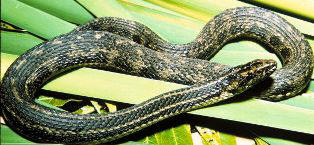 Atlantic
Salt Marsh Water Snake
(Nerodia clarkii taeniata) Threatened- In Florida the non venomous
Atlantic salt marsh snake is found along the Gulf coast from central
Florida northwest to the tip of the panhandle. Outside Florida, it is
found along the Gulf coast from Florida to southern Texas. This
Floridian snake is commonly found along the coast in brackish and
saltwater estuaries, salt marshes, and tidal mud flats. The Atlantic
salt marsh water snake is a small snake averaging 15-20 inches in
length. Adults are grayish with four dark longitudinal stripes on their
body, two on each side. The belly is reddish-brown to gray with 1 or 3
rows of light spots. The salt marsh snake is active mainly at night,
though its activity patterns may be affected by tidal patterns and
seasons. Since it does not have salt glands to help it get rid of the
salt it ingests from its estuarine habitat, in order to survive it must
obtain freshwater, such as from rain, shifting tides, or body fluids of
their prey. Atlantic
Salt Marsh Water Snake
(Nerodia clarkii taeniata) Threatened- In Florida the non venomous
Atlantic salt marsh snake is found along the Gulf coast from central
Florida northwest to the tip of the panhandle. Outside Florida, it is
found along the Gulf coast from Florida to southern Texas. This
Floridian snake is commonly found along the coast in brackish and
saltwater estuaries, salt marshes, and tidal mud flats. The Atlantic
salt marsh water snake is a small snake averaging 15-20 inches in
length. Adults are grayish with four dark longitudinal stripes on their
body, two on each side. The belly is reddish-brown to gray with 1 or 3
rows of light spots. The salt marsh snake is active mainly at night,
though its activity patterns may be affected by tidal patterns and
seasons. Since it does not have salt glands to help it get rid of the
salt it ingests from its estuarine habitat, in order to survive it must
obtain freshwater, such as from rain, shifting tides, or body fluids of
their prey. 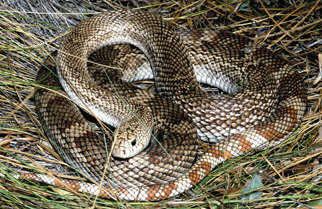 Florida
Pine Snake
(Pituophis melanoleucus mugitus) SSC- The non venomous Florida
pine snake is found throughout the state, excluding the Florida Keys,
the Everglades, extreme southwest Florida, and immediately north of Lake
Okeechobee. The Florida Pine snake averages 44- 66 inches in length and
is a large stocky snake with an indistinct pattern of reddish or dark
tan blotches on a tan, brownish gray, or rusty brown ground color. The
pattern of dark blotches is most distinct on the hind part of the body
and the tail. This Florida snake requires dry sandy soils for
burrowing. It is found most often in open pine-turkey oak woodlands and
abandoned fields, and also in scrub, sand hills, and longleaf pine
forest. When disturbed, the Florida pine snake will inflate and rear its
fore body off the ground while hissing very loudly. Due to the
alteration and fragmentation of much of Florida's upland habitats, the
pine snake is no longer found in some areas of its range and is
declining in others. Florida
Pine Snake
(Pituophis melanoleucus mugitus) SSC- The non venomous Florida
pine snake is found throughout the state, excluding the Florida Keys,
the Everglades, extreme southwest Florida, and immediately north of Lake
Okeechobee. The Florida Pine snake averages 44- 66 inches in length and
is a large stocky snake with an indistinct pattern of reddish or dark
tan blotches on a tan, brownish gray, or rusty brown ground color. The
pattern of dark blotches is most distinct on the hind part of the body
and the tail. This Florida snake requires dry sandy soils for
burrowing. It is found most often in open pine-turkey oak woodlands and
abandoned fields, and also in scrub, sand hills, and longleaf pine
forest. When disturbed, the Florida pine snake will inflate and rear its
fore body off the ground while hissing very loudly. Due to the
alteration and fragmentation of much of Florida's upland habitats, the
pine snake is no longer found in some areas of its range and is
declining in others.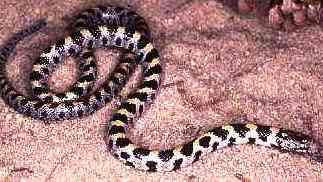 Short
Tailed Snake
(Stilosoma extenuatum) Threatened- Endemic to Florida, the non venomous
short tailed snake is considered rare because it is restricted to
limited habitats. The short-tailed snake is restricted to upland
pine-turkey oak woodlands and dry, sandy soiled habitats such as coastal
live oak hammocks and sand pine scrub. Adult snakes average 14-20 inches
in length and are very slender. Short tailed snakes are grey with dark
black or brown spots down the middle and dark spots on the sides. A
burrowing species, it is seldom seen above ground. It is thought to feed
exclusively, or nearly so, on the Florida crowned snake Short
Tailed Snake
(Stilosoma extenuatum) Threatened- Endemic to Florida, the non venomous
short tailed snake is considered rare because it is restricted to
limited habitats. The short-tailed snake is restricted to upland
pine-turkey oak woodlands and dry, sandy soiled habitats such as coastal
live oak hammocks and sand pine scrub. Adult snakes average 14-20 inches
in length and are very slender. Short tailed snakes are grey with dark
black or brown spots down the middle and dark spots on the sides. A
burrowing species, it is seldom seen above ground. It is thought to feed
exclusively, or nearly so, on the Florida crowned snake
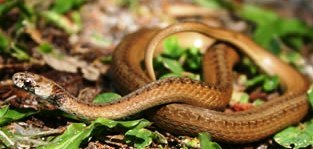 Florida
Brown Snake (Storeria dekayi victa) Threatened- A small thin
non venomous snake, the Florida brown snake averages only 7-10 inches in
length. Florida brown snakes may be rusty-brown or grayish, with a faint
light mid-dorsal stripe and flecking on the sides. There is a light band
across the back of head. There is a dark spot on the upper lip scales
under the eye. The belly is tan to pinkish, with black dots along the
edges. In Florida, it is found through out the peninsula and upper
keys.The Florida brown snake is found near hardwood hammocks, pinelands,
bogs, marshes, ponds, swamps, and sloughs, and generally feeds on slugs,
snails and earthworms. Florida
Brown Snake (Storeria dekayi victa) Threatened- A small thin
non venomous snake, the Florida brown snake averages only 7-10 inches in
length. Florida brown snakes may be rusty-brown or grayish, with a faint
light mid-dorsal stripe and flecking on the sides. There is a light band
across the back of head. There is a dark spot on the upper lip scales
under the eye. The belly is tan to pinkish, with black dots along the
edges. In Florida, it is found through out the peninsula and upper
keys.The Florida brown snake is found near hardwood hammocks, pinelands,
bogs, marshes, ponds, swamps, and sloughs, and generally feeds on slugs,
snails and earthworms.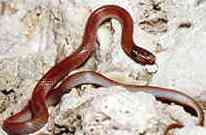 Rim
Rock Crown Snake (Tantilla oolitica) Threatened- Found only in
Dade and Monroe counties on a low elevation pine ridge called the Miami
Rim Rock formation, and upper Florida keys from Key Largo to Marathon,
this small non venomous snake measures an average 6-9 inches. Adults are
tan with a black head, chin and back of neck. The rim rock crowned snake
is a terrestrial burrower, mainly seen only under limestone rocks, logs,
leaf litter, and other debris. The type specimen came from a
now-vanished vacant lot in Miami, where it was found on the Miami Rim
Rock made up of oolitic limestone. Therefore it was given the name,
Tantilla oolitica. Since then, less than 10 individuals have found. It
is extremely rare! Rim
Rock Crown Snake (Tantilla oolitica) Threatened- Found only in
Dade and Monroe counties on a low elevation pine ridge called the Miami
Rim Rock formation, and upper Florida keys from Key Largo to Marathon,
this small non venomous snake measures an average 6-9 inches. Adults are
tan with a black head, chin and back of neck. The rim rock crowned snake
is a terrestrial burrower, mainly seen only under limestone rocks, logs,
leaf litter, and other debris. The type specimen came from a
now-vanished vacant lot in Miami, where it was found on the Miami Rim
Rock made up of oolitic limestone. Therefore it was given the name,
Tantilla oolitica. Since then, less than 10 individuals have found. It
is extremely rare!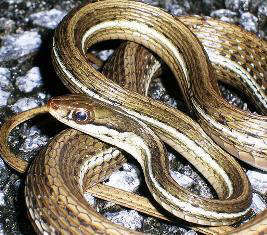 Florida
Ribbon Snake (Thamnophis sauritus sackeni) Threatened- This non
venomous snake occurs from the eastern panhandle, throughout the
peninsula. Commonly found in pinelands, hardwood hammocks, cypress
strands, prairies, marshes, streams, ponds, bogs, and stands of
melaleuca, The peninsula ribbon snake is semi aquatic and active during
the day. It is frequently found along the banks of canals and ditches,
and around houses in residential areas. After heavy rains, it is
sometimes found at night crossing roads in search of food (small fishes,
frogs, salamanders, and earthworms). Averaging 20-28 inches the Florida
Ribbon Snake slender-bodied, olive-brown with a light tan or brown
mid-dorsal stripe. Florida
Ribbon Snake (Thamnophis sauritus sackeni) Threatened- This non
venomous snake occurs from the eastern panhandle, throughout the
peninsula. Commonly found in pinelands, hardwood hammocks, cypress
strands, prairies, marshes, streams, ponds, bogs, and stands of
melaleuca, The peninsula ribbon snake is semi aquatic and active during
the day. It is frequently found along the banks of canals and ditches,
and around houses in residential areas. After heavy rains, it is
sometimes found at night crossing roads in search of food (small fishes,
frogs, salamanders, and earthworms). Averaging 20-28 inches the Florida
Ribbon Snake slender-bodied, olive-brown with a light tan or brown
mid-dorsal stripe. 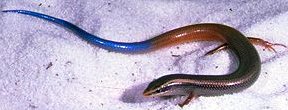 Bluetail
Mole Skink
(Eumeces egregius lividus) SSC- The bluetail mole skink is a small,
slender lizard that occupies upland habitats of the Central Ridge
peninsula of Florida. Mole skinks are found in sand hills and scrub.
They often like to be buried underground and live there. The Bluetail
Mole Skink grows to 9 to 3 to 6 inches, and a shares habitat with the
Sand Skink. Like other mole skinks, it feeds primarily on cockroaches,
spiders, and crickets. Bluetail
Mole Skink
(Eumeces egregius lividus) SSC- The bluetail mole skink is a small,
slender lizard that occupies upland habitats of the Central Ridge
peninsula of Florida. Mole skinks are found in sand hills and scrub.
They often like to be buried underground and live there. The Bluetail
Mole Skink grows to 9 to 3 to 6 inches, and a shares habitat with the
Sand Skink. Like other mole skinks, it feeds primarily on cockroaches,
spiders, and crickets.
|
|
|
Advertise | Privacy Statement | Dog Encyclopedia | Video |Contact | Alaska Nature |
|